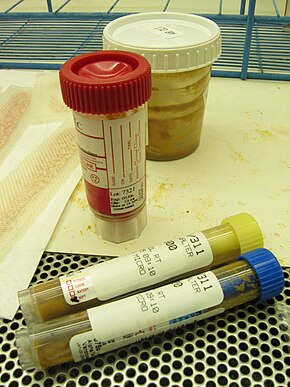Stool test
A stool test is a medical diagnostic technique that involves the collection and analysis of fecal matter. Microbial analysis (culturing), microscopy and chemical tests are among the tests performed on stool samples.
Collection
Stool samples should be sent to the laboratory as soon as possible after collection and should not be refrigerated prior to receipt by the laboratory.[1]
Visual examination
The patient and/or health care worker in the office or at the bedside is able to make some important observations.
- Color
- Texture/consistency—formed
- Classify type of feces (diagnostic triad for irritable bowel syndrome) based on Bristol stool scale
Cancer screening
Cancers, and to a lesser extent, precancerous lesions, shed abnormal cells into the stool.[4] Cancers and precancerous lesions (polyps) that are ulcerated or rubbed by passing stool also may shed blood into the stool, which can be identified by a hemoglobin assay.[4]
The
A multi-target stool DNA test was approved in August 2014 by the FDA as a screening test for non-symptomatic, average-risk adults 50 years or older.
Microbiology tests
Parasitic diseases such as
Chemical tests
A
Faecal elastase levels are becoming the mainstay of pancreatitis diagnosis.
See also
References
- ^ "Approach to stool microscopy". medilib (in Persian). 2021-06-02. Retrieved 2022-08-16.
- ^ "Fecal Occult Blood Test (FOBT)".
- S2CID 295873.
- ^ PMID 15633136.
- ^ PMID 32903904.
- ^ "American Cancer Society recommendations for colorectal cancer early detection". www.cancer.org. Archived from the original on 3 December 2016. Retrieved 14 July 2016.
- ^ National Committee for Quality Assurance. "Healthcare Effectiveness Data and Information Set 2017 Volume 2: Technical Update" (PDF).
- ^ "FDA approves first non-invasive DNA screening test for colorectal cancer [press release]". Food and Drug Administration. August 11, 2014. Retrieved 30 June 2015.
- PMID 28117881.
- PMID 26792032.
- ^ "Stool culture".
- ^ "Stool Acidity Test - MedicineNet.com".
- ^ "MedlinePlus Medical Encyclopedia: Fecal fat".

